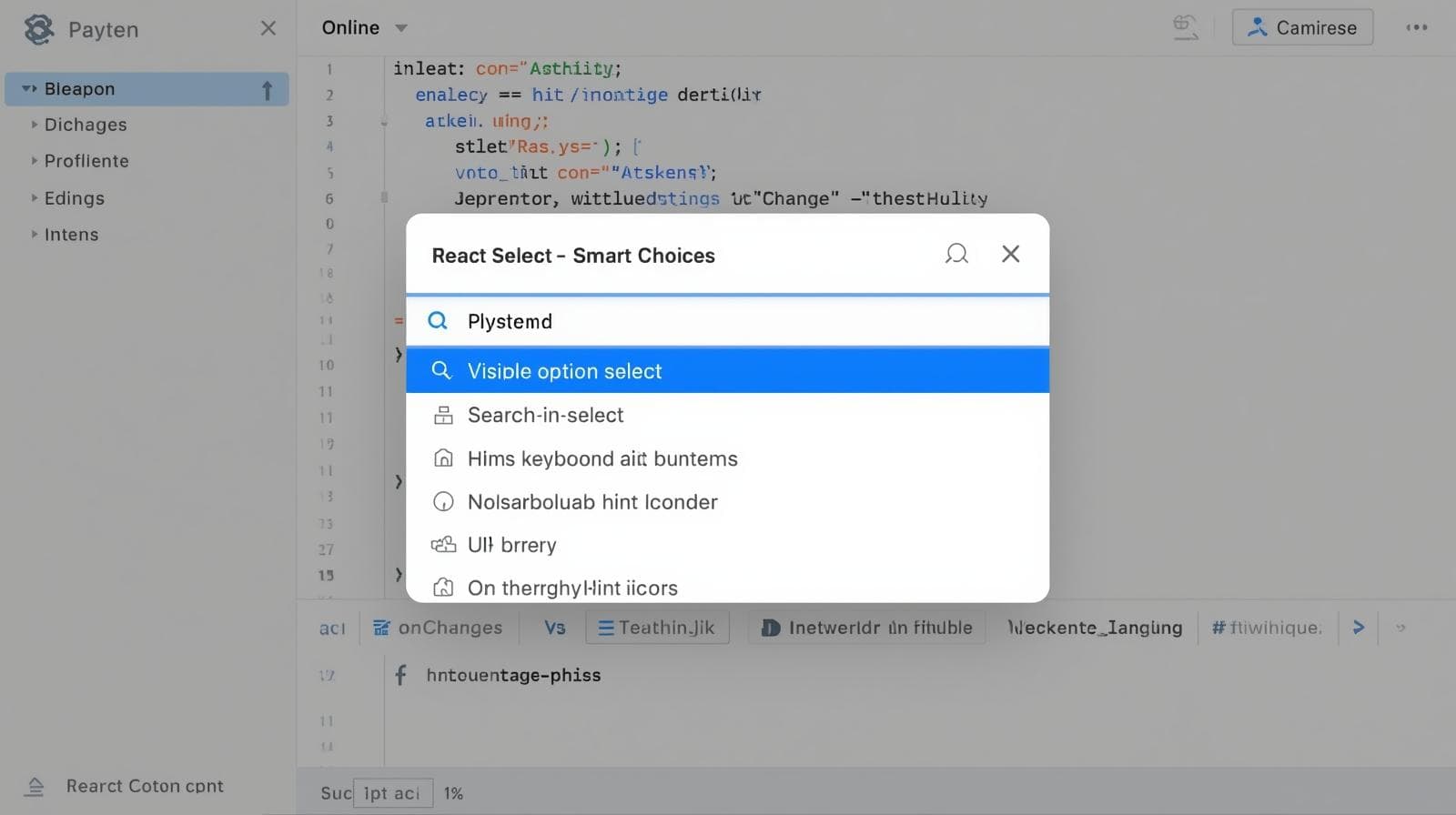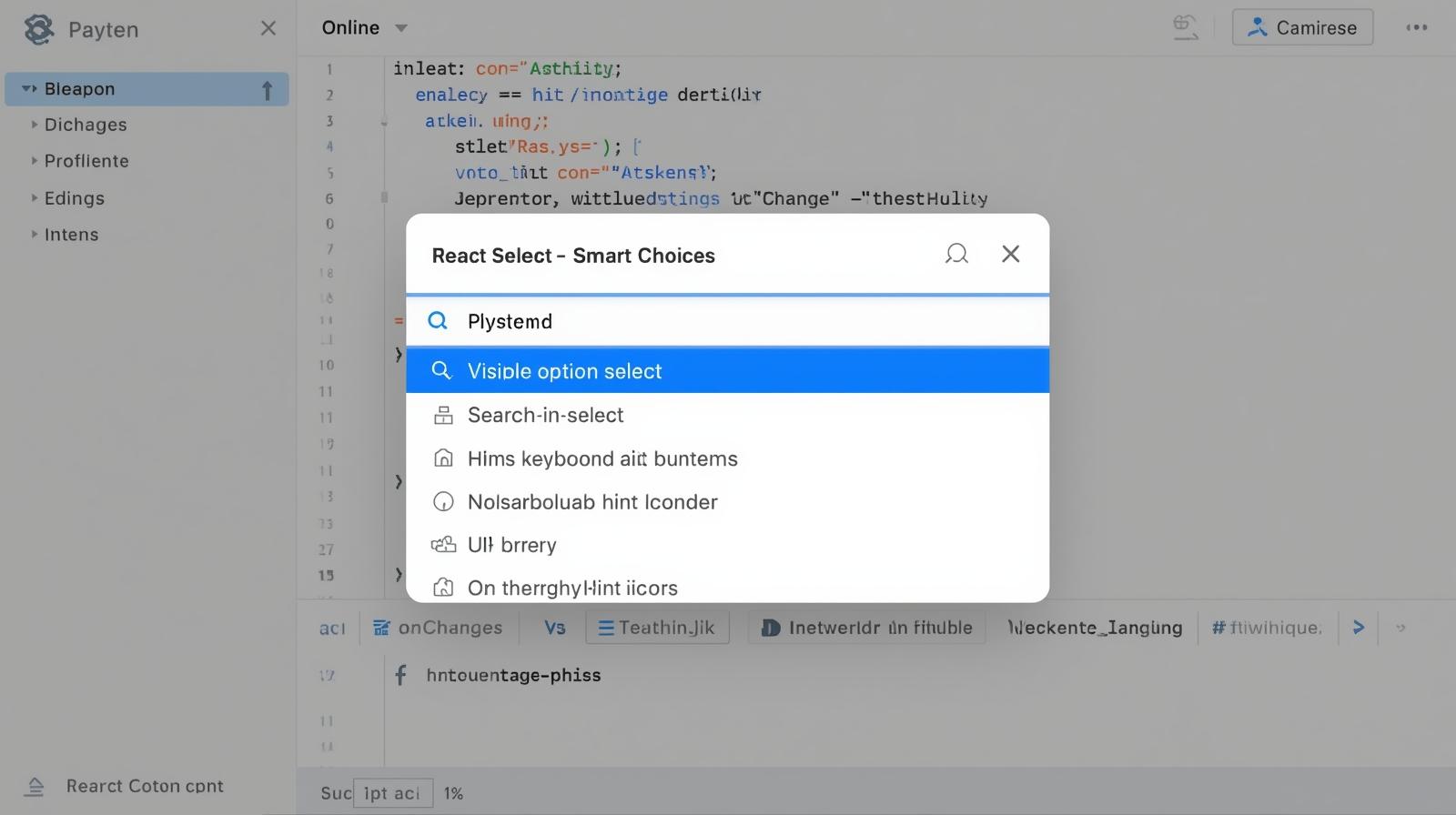Mastering React Select: A Complete Guide to Dropdowns & Form Handling

Learn how to build dynamic, controlled, and uncontrolled select dropdowns in React. This in-depth guide covers everything from basic implementation to advanced use cases, best practices, and FAQs.

Mastering React Select: A Complete Guide to Dropdowns & Form Handling
Mastering the React Select Element: Your Guide to Dynamic Dropdowns
If you've ever built a form on the web, you've almost certainly reached for a dropdown menu. They're the go-to UI element for presenting a list of options in a compact, user-friendly way. From choosing your country on a signup form to selecting a product category in an admin panel, the humble <select> tag is everywhere.
But when you bring React into the picture, things get a little more... interesting. How do you hook up this native HTML element to React's state management? How do you handle changes, pre-select values, or even allow multiple selections?
If these questions have ever crossed your mind, you're in the right place. In this deep dive, we're going to move beyond the basics and master the art of using the React Select element. We'll cover everything from simple implementations to advanced patterns, ensuring your forms are robust, accessible, and a joy to use.
The Core Concept: Controlled vs. Uncontrolled Components
Before we write a single line of code, it's crucial to understand the fundamental philosophy of forms in React: Controlled vs. Uncontrolled Components.
Uncontrolled Components: These are form elements that maintain their own internal state. It's the traditional HTML way. You can think of them as "unmanaged" by React. You might use a
refto pull the value from the DOM when you need it.Controlled Components: This is the React way. The form element's value is controlled by React's state. Any changes to the value are handled by a state update function (like
setStateor thesetfunction fromuseState). The component re-renders whenever the state changes, making the UI a direct reflection of your data.
For the <select> element, using a controlled component is almost always the recommended approach. It gives you immediate access to the value, makes validation and form submission straightforward, and aligns perfectly with React's one-way data flow.
Building Our First Controlled Select Dropdown
Let's roll up our sleeves and build a simple, controlled select component. We'll create a dropdown for selecting a favorite fruit.
jsx
import React, { useState } from 'react';
function FruitSelector() {
// 1. Create state to hold the current selected value
const [selectedFruit, setSelectedFruit] = useState('');
// 2. Handler for when the selection changes
const handleFruitChange = (event) => {
setSelectedFruit(event.target.value);
};
// 3. Form submission handler
const handleSubmit = (event) => {
event.preventDefault();
alert(`Your favorite fruit is: ${selectedFruit}`);
};
return (
<form onSubmit={handleSubmit}>
<label htmlFor="fruit-select">Choose a fruit:</label>
{/* 4. The Controlled Select Element */}
<select
id="fruit-select"
value={selectedFruit} // This controls the selected option
onChange={handleFruitChange} // This updates the state on change
>
<option value="">--Please choose an option--</option>
<option value="apple">Apple</option>
<option value="banana">Banana</option>
<option value="orange">Orange</option>
<option value="grape">Grape</option>
</select>
<button type="submit">Submit</button>
<p>Current Selection: <strong>{selectedFruit}</strong></p>
</form>
);
}
export default FruitSelector;Let's break down the key steps:
State: We use the
useStateHook to create a state variableselectedFruit. This variable will be the single source of truth for the selected value.Change Handler: The
handleFruitChangefunction is called every time the user picks a new option. It receives the event object, and we useevent.target.valueto get the new selected value and update our state.Linking State to UI: The magic happens in the
<select>tag. We set itsvalueattribute to our state variable (selectedFruit). This makes it a controlled component.The
onChangeEvent: We set theonChangeattribute to our handler function. This is the bridge that allows user interactions to update our React state.
This pattern is the backbone of handling selects in React. It's simple, powerful, and predictable.
Leveling Up: Handling Multiple Selections
What if you need a dropdown that allows users to select more than one option, like adding tags to a blog post? HTML has a multiple attribute for that, and integrating it with React is just as straightforward.
jsx
import React, { useState } from 'react';
function TagSelector() {
// State is now an Array to hold multiple values
const [selectedTags, setSelectedTags] = useState([]);
const handleTagChange = (event) => {
// event.target.options is a collection of all option elements
const selectedOptions = Array.from(event.target.options)
.filter(option => option.selected) // Get only the selected ones
.map(option => option.value); // Extract their values
setSelectedTags(selectedOptions);
};
const handleSubmit = (event) => {
event.preventDefault();
console.log('Selected Tags:', selectedTags);
};
return (
<form onSubmit={handleSubmit}>
<label htmlFor="tag-select">Choose your tags (hold Ctrl/Cmd to select multiple):</label>
<select
id="tag-select"
multiple={true} // Enable multiple selection
value={selectedTags} // Value is now an array
onChange={handleTagChange}
size="5" // Makes it look more like a multi-select box
>
<option value="react">React</option>
<option value="javascript">JavaScript</option>
<option value="webdev">Web Dev</option>
<option value="tutorial">Tutorial</option>
<option value="beginners">Beginners</option>
</select>
<button type="submit">Submit</button>
<div>
<strong>Selected Tags:</strong>
<ul>
{selectedTags.map(tag => <li key={tag}>{tag}</li>)}
</ul>
</div>
</form>
);
}
export default TagSelector;The key differences here are:
State:
selectedTagsis initialized as an empty array[].multipleAttribute: We addmultiple={true}to the<select>tag.Handler Logic: In
handleTagChange, we can't just useevent.target.value. Instead, we look atevent.target.options, filter for the selected ones, and map their values into a new array, which we then use to update the state.Linking State: The
valueprop of the<select>tag is still controlled by our state, but now it's an array of strings.
Real-World Use Case: Dynamic Options and Object Values
In a real application, your options are rarely hardcoded. They often come from an API or are dynamically generated. Furthermore, you usually need to work with entire objects (like a user or product), not just strings.
Let's create a more advanced example: a dropdown to select a user, where the value is a user ID, but we display the user's name.
jsx
import React, { useState, useEffect } from 'react';
function UserSelectForm() {
const [users, setUsers] = useState([]);
const [selectedUserId, setSelectedUserId] = useState('');
// Simulate fetching users from an API
useEffect(() => {
// This would be a fetch() call in a real app
const mockUsers = [
{ id: 1, name: 'Alice Johnson' },
{ id: 2, name: 'Bob Smith' },
{ id: 3, name: 'Carol Davis' },
];
setUsers(mockUsers);
}, []);
const handleUserChange = (event) => {
setSelectedUserId(event.target.value);
};
const handleSubmit = (event) => {
event.preventDefault();
// Find the full user object based on the selected ID
const selectedUser = users.find(user => user.id === parseInt(selectedUserId));
alert(`Selected User: ${selectedUser?.name} (ID: ${selectedUser?.id})`);
};
// Find the selected user for display
const selectedUser = users.find(user => user.id === parseInt(selectedUserId));
return (
<form onSubmit={handleSubmit}>
<label htmlFor="user-select">Select a User:</label>
<select
id="user-select"
value={selectedUserId}
onChange={handleUserChange}
>
<option value="">-- Select a User --</option>
{/* Dynamically generate options from the 'users' state */}
{users.map(user => (
<option key={user.id} value={user.id}>
{user.name}
</option>
))}
</select>
<button type="submit" disabled={!selectedUserId}>Submit</button>
{selectedUser && (
<p>You have selected: <strong>{selectedUser.name}</strong></p>
)}
</form>
);
}
export default UserSelectForm;This pattern is extremely common. The value we store in state (selectedUserId) is a simple primitive (a string or number), which is perfect for form submission. However, we use that ID to look up the full, rich object from our users array whenever we need to display more information or perform an action.
Best Practices for a Flawless User Experience
Always Use a Label: Every
<select>should have a corresponding<label>with ahtmlForattribute matching theselect'sid. This is crucial for accessibility.Provide a Clear Default Option: A disabled option like
"-- Please choose --"with an empty value guides the user and helps with validation.Use
htmlForandid: This connection not only helps with accessibility but also improves usability by making the label clickable, which focuses the select dropdown.Controlled Components are King: Embrace the controlled component pattern. It simplifies everything from validation to resetting the form.
Consider a Third-Party Library for Complex Cases: If you need features like search, async loading, or highly customized styling, libraries like
react-selectare fantastic. They handle a lot of the complex logic for you. Want to learn how to integrate powerful third-party libraries like this into professional projects? To learn professional software development courses such as Python Programming, Full Stack Development, and MERN Stack, visit and enroll today at codercrafter.in.
Frequently Asked Questions (FAQs)
Q: How do I set a default selected value?
A: In a controlled component, you set the default by initializing your state variable with the desired value. For example, useState('apple') would pre-select the "Apple" option.
Q: How can I reset a select dropdown?
A: Since it's controlled by state, resetting is easy. Just set the state variable back to its initial value (e.g., setSelectedFruit('') or setSelectedTags([])).
Q: My onChange handler isn't firing. What's wrong?
A: Double-check your casing! It must be onChange in camelCase, not onchange.
Q: Why is my select not updating when the state changes?
A: Ensure you are using the value prop (or defaultValue for uncontrolled) and not the selected attribute on the <option> tags. In a controlled component, React uses the value on the <select> itself to determine what is selected.
Conclusion
The React <select> element, when mastered, is a powerful tool in your form-building arsenal. By understanding and implementing the controlled component pattern, you gain fine-grained control over your form's data and behavior. We've covered the journey from a simple single-select dropdown to a dynamic, multi-select component that interacts with object-based data.
Remember, the principles of state management, one-way data flow, and accessibility are what make your React forms robust and maintainable. Practice these patterns, and you'll be building complex, user-friendly forms with confidence.
Feeling inspired to build more dynamic, full-featured web applications? The concepts covered here are just the beginning. To learn professional software development courses such as Python Programming, Full Stack Development, and MERN Stack, visit and enroll today at codercrafter.in. Our project-based curriculum is designed to take you from foundational concepts to building and deploying real-world applications